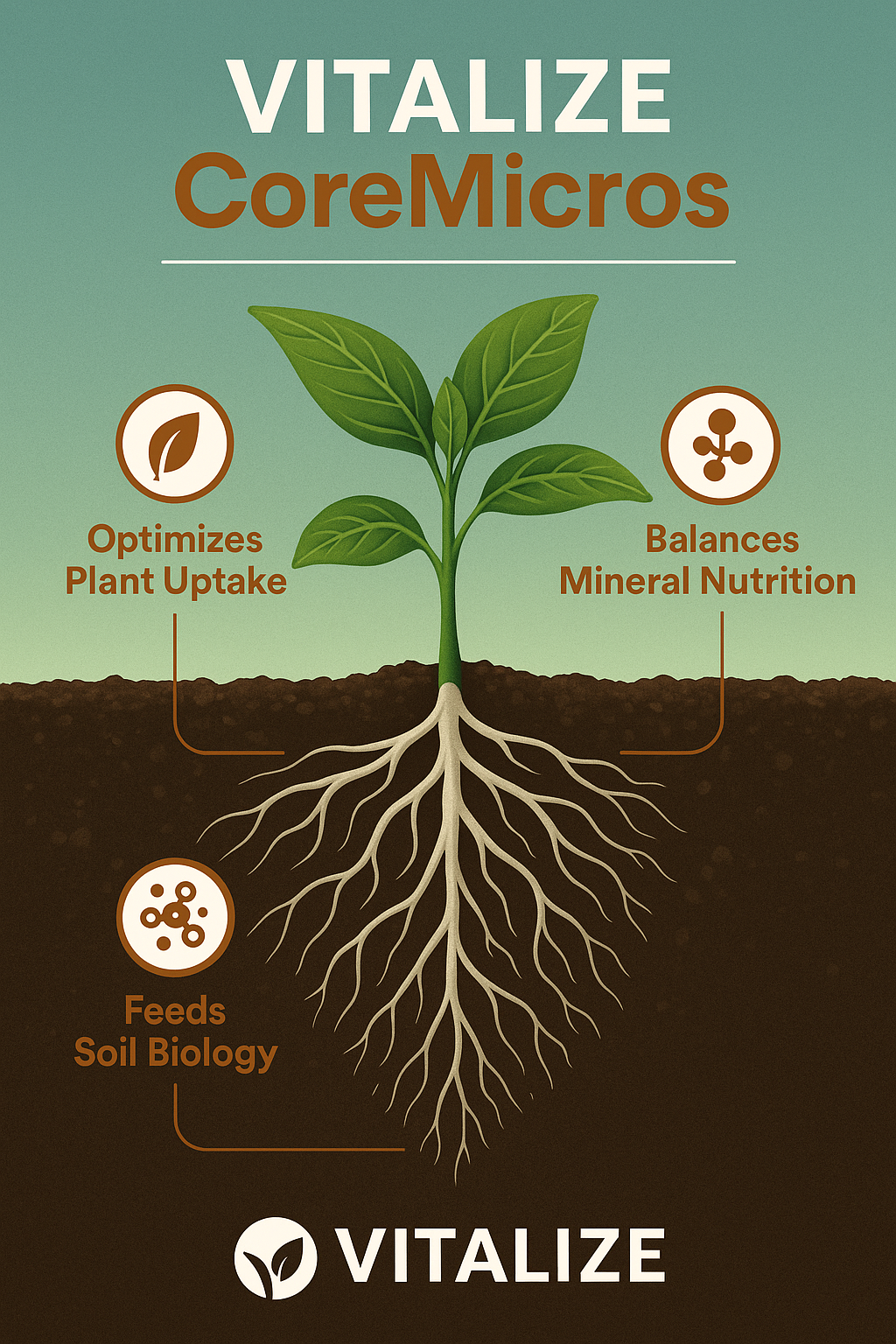
Vitalize CoreMicros: Unlocking Micronutrient Power for Soil Health and Plot Success
Share
Building better soil starts below the surface. At Vitalize Seed, we talk a lot about macronutrients, soil carbon, and biology, but there’s a layer of fertility that often gets overlooked: micronutrients. That’s where CoreMicros comes in.
This isn’t just a bag of trace minerals. It’s a targeted, soil-smart blend that includes nutrients often left out of conventional programs, like molybdenum, which plays a critical role in nitrogen metabolism but is rarely included in granular products. CoreMicros fits seamlessly into our One-Two System and provides value in both spring and fall applications.
What Is Vitalize CoreMicros?
CoreMicros is a dry, granulated micronutrient and biological support product formulated to feed the plant and support soil function. It includes:
-
Gypsum (Calcium and Sulfur): Supports soil structure and base saturation balance
-
Humic substances: Improve nutrient retention, chelation, and microbial efficiency
-
Copper (Cu), Zinc (Zn), Manganese (Mn), Boron (B): Essential for enzymatic function, root growth, photosynthesis, and reproductive development
-
Molybdenum (Mo): Critical for nitrate metabolism and legume nitrogen fixation, and rarely found in most granular micros
Why Iron Is omitted
You might notice iron (Fe) is not part of the CoreMicros blend. That’s intentional. In most agricultural soils, iron is already present in high quantities, especially in mineral-rich, Midwest and Eastern soils. While iron deficiencies can occur in high pH or calcareous soils, they are the exception, not the rule.
Adding more iron to an already sufficient system can cause antagonism with other micronutrients, particularly manganese, phosphorus, and molybdenum. Rather than include it just for the sake of a label, we chose to leave iron out and let your soil test determine if a specific correction is needed.
What makes this blend unique is its balance of biological compatibility and mineral support. Each ingredient is selected for both immediate plant uptake and long-term microbial cycling.
Why Micronutrients Matter, Especially Molybdenum
Micronutrient deficiencies are one of the most underdiagnosed yield limiters in food plot and row crop systems. While elements like zinc and boron are commonly discussed, molybdenum (Mo) is often completely overlooked.
| Micronutrient | Function |
|---|---|
| Zinc (Zn) | Activates enzymes tied to auxin synthesis and root elongation |
| Boron (B) | Supports cell wall structure, reproductive development, and sugar transport |
| Manganese (Mn) | Drives photosynthesis and nitrogen use |
| Copper (Cu) | Enhances disease resistance and lignin formation |
| Molybdenum (Mo) | Activates nitrate reductase enzyme and supports Rhizobia nodulation in legumes |
Why Molybdenum Is Different
-
Mo is required in extremely small amounts, yet it plays an outsized role in nitrogen use efficiency
-
Without molybdenum, plants struggle to convert nitrate into usable amino compounds
-
Legumes like clover, alfalfa, and hairy vetch need Mo to fuel biological nitrogen fixation
-
Soils with low pH or low organic matter, especially in the Northeast, Midwest, and Southeast, often limit Mo availability
-
Most micronutrient blends don’t include it at all. CoreMicros does
This inclusion is especially important for growers using No-Till Nurture, REGEN N+, and biologically active cover crop systems. Molybdenum ensures that nitrogen, whether applied or fixed, is actually usable.
Where It Fits in the System
CoreMicros is designed to integrate across a wide range of planting approaches:
-
With Spring Nitro-Boost: Balances micros, sulfur, and early calcium needs
-
With Fall Carbon-Load: Complements high-biomass species with root and mineral support
-
Perennials (Clover, Chicory, Alfalfa): Adds the boron and molybdenum needed for nodulation and cell division
-
Paired with No-Till Nurture: Forms a complete granular base fertility program
-
Stacked with Vitalize Foliars: Enhances the total system by improving soil-to-root nutrient cycling
It can be applied pre-plant, top-dressed ahead of a rain, or even worked into the top inch during seedbed prep.
Application Timing and Use
| Use Case | Timing | Rate | Placement |
|---|---|---|---|
| Annual food plots | Pre-plant | ~22.5 lbs/acre | Broadcast or incorporated |
| Clover/perennial plots | Spring or Fall | ~22.5 lbs/acre | Top-dress before rainfall |
| Paired with No-Till Nurture | Spring or Fall | Same-day application | Layered in or surface spread |
Because CoreMicros includes boron and molybdenum, overapplication should be avoided. These nutrients are powerful, even at low rates, and are most effective when managed as part of a complete soil-building system.
How It All Comes Together: Cycling Nutrients From Foliar to Root
Soil fertility is more than just what’s in the soil. It’s how nutrients move, how they’re taken up, and how they’re cycled.
When we apply foliar products like Revive RX, Bio-Charge, or REGEN N+, we’re not just fertilizing leaves. We’re:
-
Adding essential nutrients directly to plant foliage
-
Feeding microbial communities both on the leaf surface and in the rhizosphere
-
Supplying trace elements and amino acids that increase efficiency and stress resilience
At the same time, foundational products like No-Till Nurture, lime, and CoreMicros are working beneath the surface to:
-
Balance pH and base saturation
-
Improve soil structure and nutrient holding capacity
-
Provide stable forms of calcium, sulfur, and trace minerals
-
Feed fungi and bacteria that mineralize nutrients over time
When combined in our One-Two System, these practices create a biological loop that:
-
Keeps nutrients in the system longer
-
Reduces leaching and chemical tie-up
-
Increases the availability of locked-up nutrients
-
Unlocks the natural fertility potential of your soil
Why Use CoreMicros?
Broadcast fertilizer programs often focus only on NPK, and even then, placement and tie-up are major concerns. Micronutrients are no different. They are easily tied up in soil, especially when applied without a biological partner or chelating agent.
CoreMicros addresses this by:
-
Placing minerals where biology can access them
-
Feeding both the plant and the rhizosphere
-
Improving root uptake through humic-enhanced delivery
-
Including molybdenum, a rare but essential piece of the nitrogen puzzle
-
Supporting year-over-year improvements in soil structure, nutrient cycling, and microbial activity
For growers using balanced blends, cover cropping, or biological foliar programs, this product simply makes sense.
Don’t Take Our Word for It — Here’s the Science
-
Molybdenum is a required cofactor for the enzyme nitrate reductase, which converts nitrate into amino acids usable by plants (Kaiser et al., 2005)
-
Mo is also essential for the nitrogenase enzyme in legumes, directly impacting the success of nitrogen fixation by Rhizobia (Gupta & Lipsett, 1981)
-
Humic substances increase the bioavailability of trace minerals by chelating them, improving root uptake in both acidic and alkaline soils (Kulikova et al., 2005)
-
Zinc and manganese deficiencies are linked to poor root development and impaired photosynthesis, especially under high-residue, low-CEC conditions (Alloway, 2008)
-
Boron deficiency is tied to poor seed development, sugar transport, and nodulation failure in legumes and brassicas (Shorrocks, 1997)
This blend is built around those insights, not just tradition.
Final Thoughts
At Vitalize Seed, we believe in doing more with less. Smarter applications, balanced blends, and biology-first soil management. CoreMicros is a key piece of that approach.
If you’re planting legumes, using biological fertilizers, or building soil carbon, don’t overlook the micros. Especially molybdenum. It might be the missing link.
CoreMicros is ready to fill that gap. Field-proven, science-backed, and built for growers who care about doing it right.
Related Products
-
No-Till Nurture: https://vitalizeseed.com/products/no-till-nurture
-
Bio-Charge: https://vitalizeseed.com/products/bio-charge
-
Revive RX: https://vitalizeseed.com/products/revive-rx
-
Seed Feed: https://vitalizeseed.com/products/seed-feed
-
Vitalize Foliars: https://vitalizeseed.com/collections/foliar
